Chinstrap penguins are a favorite among wildlife enthusiasts, not least for their black and white plumage that looks like they are wearing a cute little helmet on their heads.
In this article, we’ll dive into some fascinating facts about chinstrap penguins, covering everything from their habitat and diet to their breeding habits and conservation status.
So, whether you’re planning to see these adorable birds for yourself, or you just love a good old penguin fact, there will be something for you here.
1. They are found in Antarctica and on sub-Antarctic Islands
The Chinstrap Penguin is found in Antarctica and islands in the sub-Antarctic region including the South Sandwich Islands, the South Orkneys, South Shetland, South Georgia, Bouvet Island, and the Balleny Islands.
In Antarctica, Chinstrap penguins only breed on the Antarctic peninsular which is where more than half of the Antarctic penguins can be found.
Between April and September when they aren’t breeding, they often move long distances from their colonies. Some have been recorded moving from their colony in the South Shetland Islands to the boundary of the Upper Ross, a journey of around 4,000km1 (source: Penguins: Natural History and Conservation).
The below map gives a rough idea of where the different penguins live in the southern hemisphere.
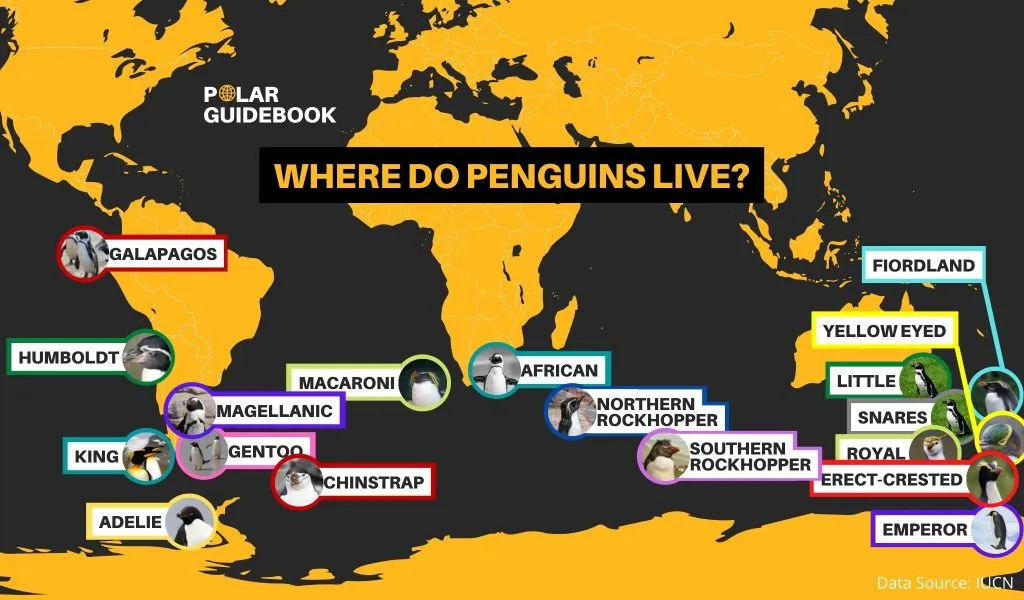
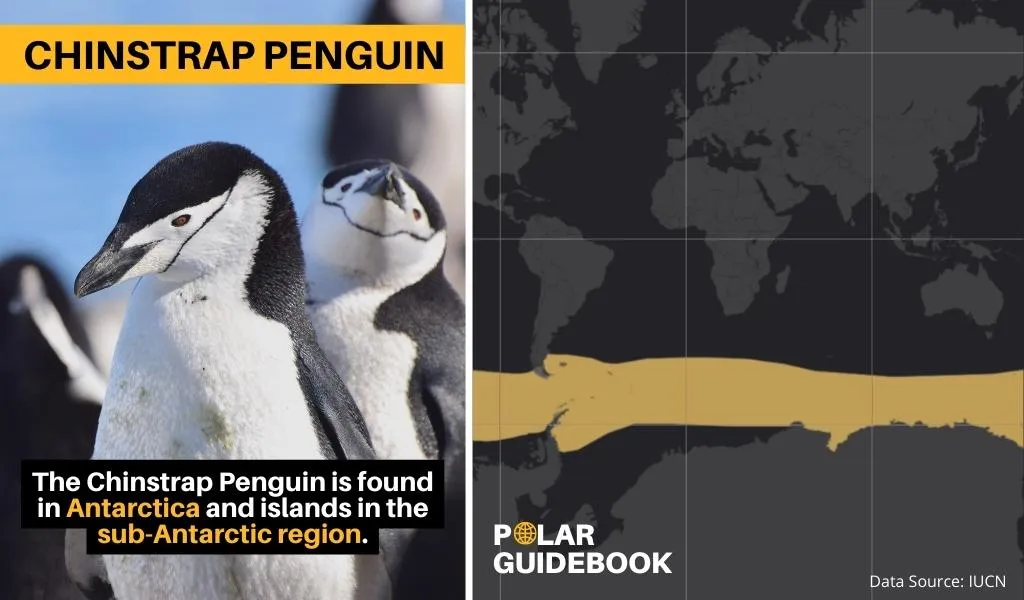
2. They are nicknamed the stonebreaker penguin
Chinstrap penguins are sometimes called stonebreaker penguins which sounds like it could be the name of a wrestler. However, the nickname actually refers to their loud call which is like a screeching noise. Apparently, the noise is so shrill that it could break stones.
3. They look like they are wearing a little black helmet
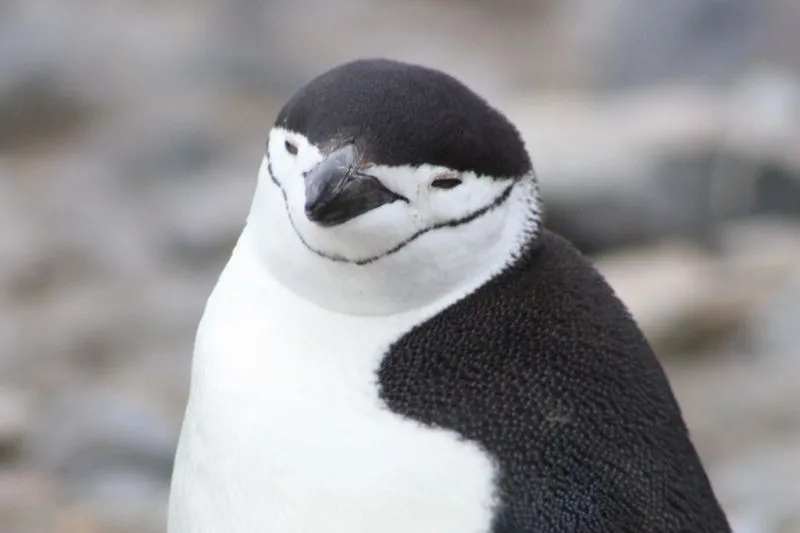
Chinstrap penguins are most closely related to Adelie and Gentoo penguins, the other two living species in the family of pygoscelis penguins which split from other species around 38 million years ago2 (source: Wikipedia).
All three members of the family have very stiff tail feathers that stick out like a brush, giving them their nickname, brush-tailed penguins.
Chinstrap penguins are easy to identify because they have a very distinct line of black feathers that runs under their chin from ear to ear, making it look like they are wearing a little black helmet with a chinstrap.
4. They are medium-sized penguins at 46-61cm tall
Chinstrap penguins are medium-sized penguins standing anywhere between 46–61 cm (18–24”) tall. Although they the smallest in the Pygoscelis family of penguins (also known as brush tailed penguins)3 (source: Seaworld).
Chinstraps can weigh anywhere between 3-4.5kg (6.5-10lbs)4 (source: Animal: The Definitive Visual Guide) Both males and females look similar although males are generally heavier.
The below graphic from our guide to ‘how big are penguins‘ gives a relative scale of their size compared to other species.
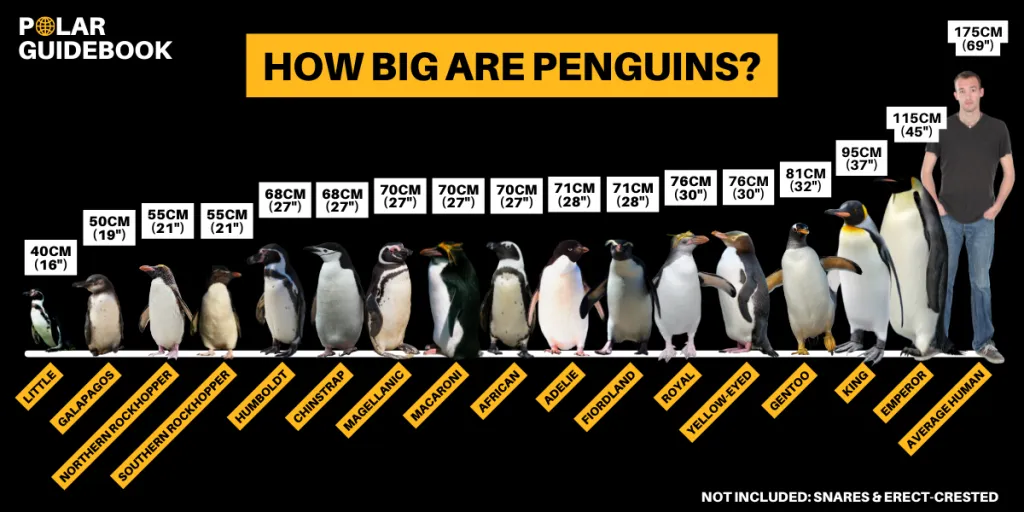
5. Chinstrap penguins have a lifespan of 15-20 years in the wild
The lifespan of a chinstrap penguin is between 15-20 years old in the wild.
When taking into account all species, penguins have a lifespan of 20 years so this is about average.
In captivity, penguins can live for much longer. Typically, penguins in zoos or aquariums live to around 30 years old. The oldest known chinstrap penguin in Fox, a 37-year-old living at Moody Garden Aquarium in Texas5 (source: KSAT).
6. They are the second most common penguin
With a population of around 8 million, Chinstrap penguins are the second most common type of penguin (after Adélie penguins) and make up around one-quarter of the total penguin population (currently around 30-31 million)6 (source: IUCN).
Although some penguin species are endangered, this is not the case with chinstrap penguins which are listed as ‘least concern’, the lowest level of endangerment by the IUCN.
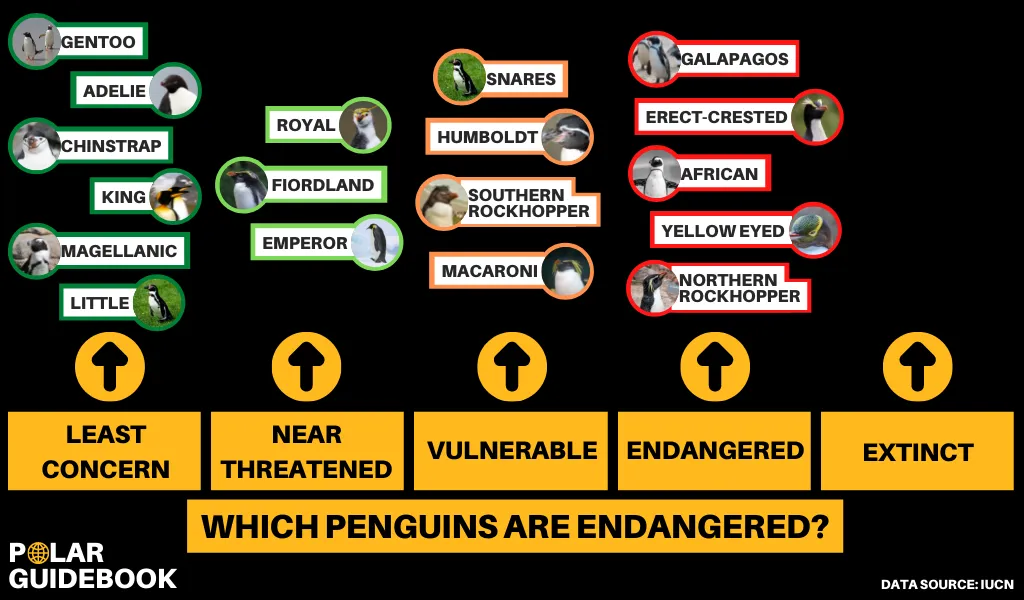
However, they are still impacted by the effects of climate change and have a declining population. They face reduced breeding success and their major food source, krill, is also threatened by the changing sea temperatures7 (source: Earth.org).
7. They are black and white for camouflage
Chinstrap penguins have black-blue feathers on their back and tail which is an important part of their camouflage called countershading. It helps them blend in when they are underwater which is where most of their predators are found.
When you look at them from below, their lighter-colored belly matches the light in the water above. And when you look at them from above, their black-blue back matches the dark water below8 (source: H.M. Rowland, The Royal Society B Biological Sciences, Issue 364, 2008).
8. They can dive up to 70m deep
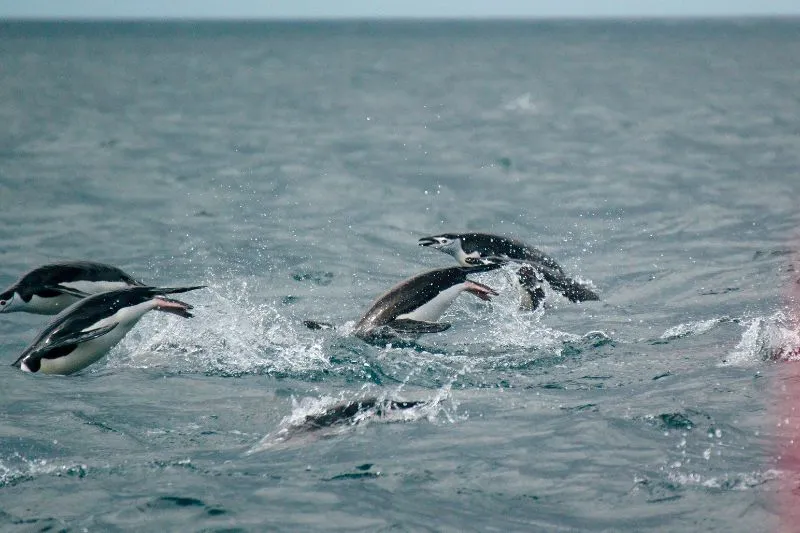
Chinstrap penguins, like most other species, must forage for their food in the ocean so they are well adapted for swimming and diving (likely the reason why penguins cannot fly).
Chinstrap penguins are able to dive as deep as 70 m (230 ft) below the surface, however, they spend most of their time in depths less than 40m (131ft).
They forage for food during the day and night, however, night time dives are generally much shallower and result in a higher proportion of fish compared to dives in the day when they mainly consume krill.
9. They are able to drink salt water thanks to a special salt gland
Chinstrap penguins spend most of their lives at sea where they can ingest high levels of salt water whilst consuming their prey.
Since their kidneys are not very efficient at processing salt, they have a special salt gland (also known as a super orbital gland) at the top of their skull, near their eye, which removes salt from their blood.
The salt is excreted in water droplets through their nostrils by sneezing or shaking their head9 (source: Britannica).
Chinstrap penguins have a relatively large salt gland compared to most other species. This is because they have a higher proportion of marine invertebrates in their diet which are very salty compared to fish10 (source: S.L. Hauserman, et al., The Smithsonian Institution).
10. They eat mostly Antarctic Krill
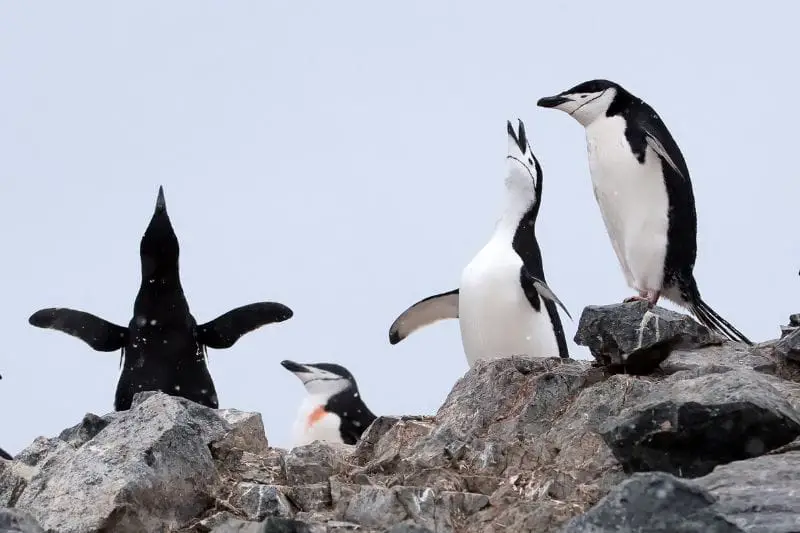
The diet of a chinstrap penguin predominately consists of Antarctic Krill which can be up to 99% of their diet by weight depending upon where they are foraging11 (source: A.Lynnes, et al, Polar Biology, Vol. 27, No. 9pp. 544-554, 2004).
They are also known to eat fish, especially those that take overnight foraging trips to the shelf break where more fish can be found. When consuming fish, they tend to consume pelagic fish (i.e. those that are not close to the bottom of the ocean or the shore).
Because of the species’ reliance on Antarctic Krill, significant changes in availability (for example, due to the growing number of Antarctic fur seals which also feed on Antarctic Krill) could have a serious knock-on effect to the population of Chinstrap penguins12 (source: C.Niemandt, Antarctic Science, Vol. 28, Issue 2, 2016, pp. 91 – 100).
See how their diet compares to other species in our full guide to what penguins eat.
11. Their main predators are seals, skuas, and petrels
The main predators of Chinstrap penguins on land are brown skua, south polar skua, and southern giant petrel, whilst in the water, their main predators are leopard seals.
Skua and petrel will spend time at penguin colonies looking for vulnerable targets to prey upon. Skuas tend to look for eggs and young chicks, whereas giant petrels wait until the chicks have left the nest and are left in creches whilst the adults go out to forage for food.
Leopard seals tend to occupy areas around chinstrap penguin colonies, preying on penguins as they leave the colony to forage for food at sea. They can take up to 20% of breeding adult chinstrap penguins in any given year13 (source: T.R. Mader, Montana State University).
12. Both males and females play a role in raising the young
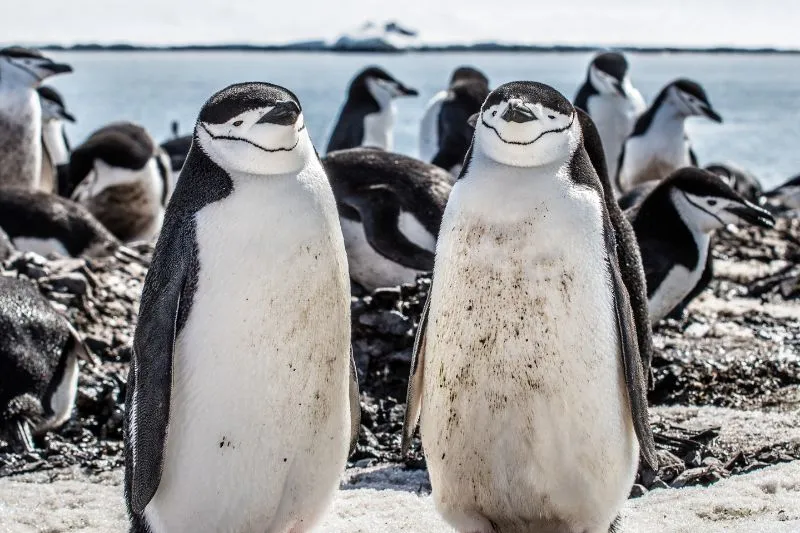
Male and female chinstrap penguins share parenting duties, starting with incubation. They take turns incubating the eggs, starting with 5-10 day shifts and getting increasingly shorter as they approach hatching.
Once the chicks are born, they enter the guarding stage where one parent will stay at the nest to protect the newly born chicks whilst the other forages for food at sea.
Once the chicks are old enough, they can be left in large groups with other chicks (called a creche) while both parents forage for food14 (source: Penguins: Natural History and Conservation).
13. Chinstrap Penguins can be in same-sex partnerships
Our final Chinstrap penguin fact is that, like many other penguins, Chinstrap penguins have been known to engage in same-sex relationships.
This can happen in the wild or in captivity. Two of the most famous gay penguins were Roy and Silo, two chinstrap penguins who lived at Central Park Zoo in New York.
After attempting to hatch a rock, zookeepers gave them an abandoned egg. They were the first same-sex penguin couple to hatch and raise an egg. Their story was the basis of the 2005 children’s book, And Tango Makes Three.


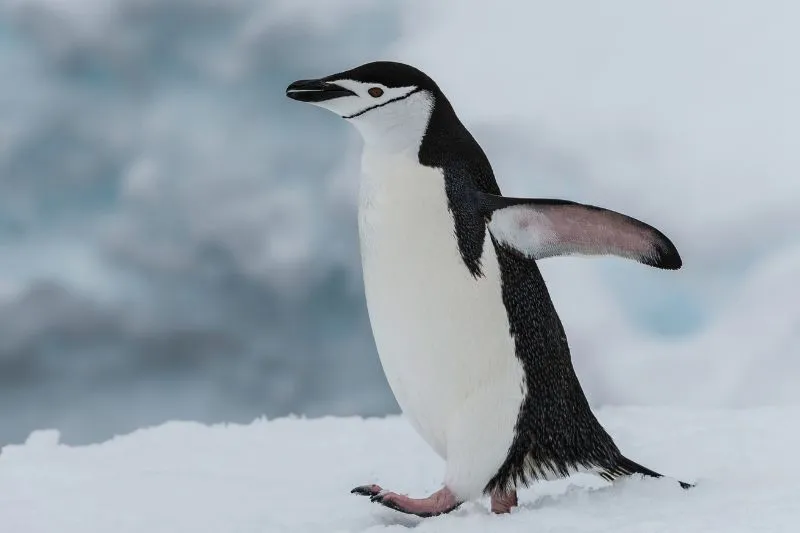
![Read more about the article How Big Are Penguins? [Height & Weight of Every Species]](https://polarguidebook.com/wp-content/uploads/2022/02/how-big-are-penguins-300x176.jpg)
![Read more about the article 11 Facts About Snares Penguins [#6 Will Make You Want to Save Them]](https://polarguidebook.com/wp-content/uploads/2023/01/Snares-Penguin-2-300x200.jpg)
![Read more about the article Why Are Penguins Black and White? [Full Color Palette Explained]](https://polarguidebook.com/wp-content/uploads/2022/01/What-color-are-penguins-300x176.jpg)